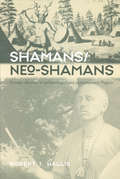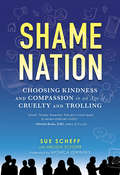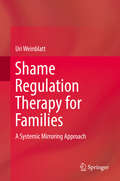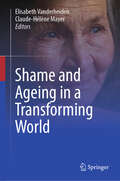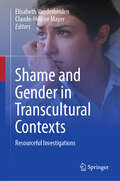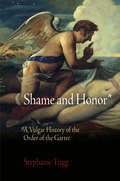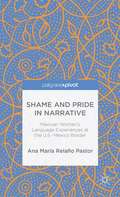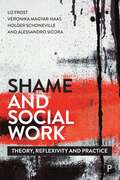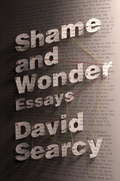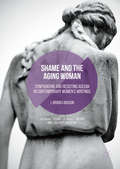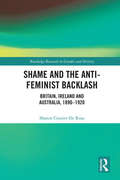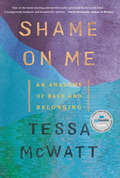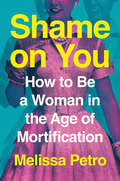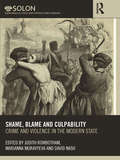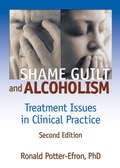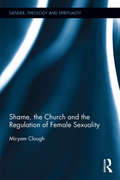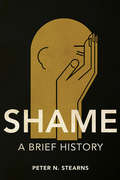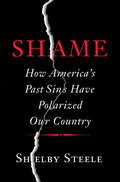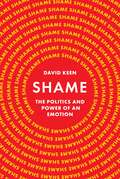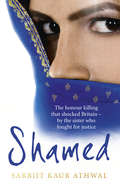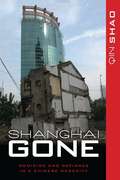- Table View
- List View
Shamans/Neo-Shamans: Ecstasies, Alternative Archaeologies and Contemporary Pagans
by Robert J. WallisIn popular culture, such diverse characters as occultist Aleister Crowley, Doors musician Jim Morrison, and performance artist Joseph Beuys have been called shamans. In anthropology, on the other hand, shamanism has associations with sorcery, witchcraft and healing, and archaeologists have suggested the meaning of prehistoric cave art lies with shamans and altered consciousness. Robert J. Wallis explores the interface between 'new' and prehistoric shamans. The book draws on interviews with a variety of practitioners, particularly contemporary pagans in Britain and north America. Wallis looks at historical and archaeological sources to explore contemporary pagan engagements with prehistoric sacred sites such as Stonehenge and Avebury, and discusses the controversial use by neo-Shamans of indigenous (particularly native American) shamanism.
Shame Nation: The Global Epidemic Of Online Hate
by Melissa Schorr Sue Scheff Monica Lewinksy"Engaging, sharp, and important — Shame Nation will inspire you to open your eyes and be better." — Theresa Payton, CEO of Fortalice Solutions and Deputy Director of Intelligence on CBS' HuntedIn today's digitally driven world, disaster is only a click away. A rogue tweet could bring down a business; an army of trolls can run a celebrity off-line; and virtual harassment might cause real psychological damage. Shame Nation is the first book to both study the fascinating phenomenon of online shaming, and offer practical guidance and inspiring advice on how to prevent and protect against cyber blunders and faceless bullies. Author and acclaimed Internet safety expert Sue Scheff unveils all sides of an issue that it only becoming more relevant day by day while drawing from the expertise of other top professionals spanning fields including law, psychology, and reputation management.From damning screenshots to revenge porn, Shame Nation shines a light on the rising trend of an online shame culture and empowers readers to take charge of their digital lives.
Shame Regulation Therapy for Families: A Systemic Mirroring Approach
by Uri WeinblattThis accessible guide introduces systemic mirroring, an innovative approach to understanding and managing the disruptive presence of shame in family therapy. Shame is analyzed in individual and interpersonal contexts, and in two basic problematic states—experiencing too much or too little shame—often found at the root of serious problems between children and their parents. The author offers potent conversation-based strategies for working with children, adolescents, and their families, and for working with parents to resolve their own shame issues so they can improve their relationships with their children. The author also illustrates how shame regulation can improve the bond between client and therapist and produce lasting effects as clients learn to disengage from shame. This practical resource: Offers an innovative approach to dealing with shame in therapy Integrates practical methods for use with children, adolescents, and parents Discusses how shame derails interpersonal communication Provides interventions for shame management and dealing with the state of shamelessness Shows how parents can regulate their own shame at the couple level Applies these methods to school settings Shame Regulation Therapy for Families aides the work of professionals such as psychologists, psychiatrists, social workers, and school psychologists who work with children and their families on shame management.
Shame and Ageing in a Transforming World
by Elisabeth Vanderheiden Claude-Hélène MayerThe book provides a comprehensive overview of research and concepts related to shame and ageing, in the context of social change, upheavals and paradigm shifts, from transdisciplinary, cultural and transcultural perspectives. Drawing upon the editors' previous works on the topic of shame, this volume discusses the contexts of shame and ageing from theoretical, conceptual, and empirical perspectives. The toxic and stressful aspects of shame have been the focus of scientific analysis and discourse on shame and ageing. This volume explicitly makes the dimensions of shame a resource for individuals, and collective transformation processes the object of research in the context of ageing. It looks at emerging lifestyle, political, socio-economic and health contexts. It looks at how and why the frequency, intensity and handling of feelings of shame change over the course of life; the impact of shame on emotional well-being and mental health of older people; the impact of shame on social relationships and social engagement of older people in different cultures; the role of cultural values and norms in the development and processing of feelings of shame, especially in older people, and how these can be used for self-development; and the differences in the way older people in different cultures deal with feelings of shame and the way these can be used to develop effective strategies and techniques for older people to cope with shame. The editors and contributors thereby take cultural and gender aspects, as well as positive psychology and resource-orientated concepts, such as salutogenesis, resilience, happiness, fortitude, locus of control, faith- or strengths-based approaches into account and contextualize them against processes of social upheaval and transformation.
Shame and Gender in Transcultural Contexts: Resourceful Investigations
by Elisabeth Vanderheiden Claude-Hélène MayerThis volume is envisioned as a primary reference in research, studies and concepts on shame through the lens of gender and from transdisciplinary, cultural and transcultural perspectives. It sheds light on the state of the art regarding shame and its meaning in the context of gender from theoretical, conceptual, and empirical perspectives from the standpoint of positive psychology. Since the experience of shame, the expression of shame as well as the individual or collective handling of shame depends in a special way on cultural factors, special importance has been given in the chapters to the consideration of cultural framework conditions. This volume is founded on the editors' first three publications on shame from positive psychology perspectives and an upcoming work on shame and ageing.
Shame and Honor
by Stephanie Trigg"It's a nice piece of pageantry. . . . Rationally it's lunatic, but in practice, everyone enjoys it, I think."--HRH Prince Philip, Duke of EdinburghFounded by Edward III in 1348, the Most Noble Order of the Garter is the highest chivalric honor among the gifts of the Queen of England and an institution that looks proudly back to its medieval origins. But what does the annual Garter procession of modern princes and politicians decked out in velvets and silks have to do with fourteenth-century institutions? And did the Order, in any event, actually originate in the wardrobe malfunction of the traditional story, when Edward held up his mistress's dropped garter for all to see and declared it to be a mark of honor rather than shame? Or is this tale of the Order's beginning nothing more than a vulgar myth?With steady erudition and not infrequent irreverence, Stephanie Trigg ranges from medieval romance to Victorian caricature, from imperial politics to medievalism in contemporary culture, to write a strikingly original cultural history of the Order of the Garter. She explores the Order's attempts to reform and modernize itself, even as it holds onto an ambivalent relationship to its medieval past. She revisits those moments in British history when the Garter has taken on new or increased importance and explores a long tradition of amusement and embarrassment over its formal processions and elaborate costumes. Revisiting the myth of the dropped garter itself, she asks what it can tell us about our desire to seek the hidden sexual history behind so venerable an institution.Grounded in archival detail and combining historical method with reception and cultural studies, Shame and Honor untangles 650 years of fact, fiction, ritual, and reinvention.
Shame and Pride in Narrative: Mexican Women’s Language Experiences at the U.S.–Mexico Border
by Ana María Relaño PastorThis book analyzes personal experiences of language through the voices of Mexican immigrant women, in relation to the racialization discourses that frame the social life of Mexican immigrant communities in the United States. It reveals the power of narrative, understood as a social practice, to validate and give meaning to people's lives.
Shame and Social Work: Theory, Reflexivity and Practice
by Liz Frost, Veronika Magyar-Haas, Holger Schoneville and Alessandro SicoraFor many service users and professionals in the field of social work, shame is an ongoing part of their daily experience. Providing an in-depth examination of the complex phenomena of shame and humiliation, this book sets out key contextual issues and theoretical approaches to comprehend shame and its relevance within social work. It provides a broad understanding of shame, its underlying social and political contexts and its effects on service users and professionals. The book uses innovative international scholarship and includes theoretical considerations, as well as empirical findings within the field of social work. It shows the importance of sensitive, reflective and relationship-oriented practice based on a better understanding of the complexity of shame.
Shame and Wonder
by David SearcyFor fans of John Jeremiah Sullivan, Leslie Jamison, Geoff Dyer, and W. G. Sebald, the twenty-one essays in David Searcy's debut collection are captivating, daring--and completely unlike anything else you've read before. Forging connections between the sublime and the mundane, this is a work of true grace, wisdom, and joy.Expansive in scope but deeply personal in perspective, the pieces in Shame and Wonder are born of a vast, abiding curiosity, one that has led David Searcy into some strange and beautiful territory, where old Uncle Scrooge comic books reveal profound truths, and the vastness of space becomes an expression of pure love. Whether ruminating on an old El Camino pickup truck, those magical prizes lurking in the cereal boxes of our youth, or a lurid online ad for "Sexy Girls Near Dallas," Searcy brings his unique blend of affection and suspicion to the everyday wonders that surround and seduce us. In "Nameless," he ruminates on spirituality and the fate of an unknown tightrope walker who falls to his death in Texas in the 1880s, buried as a local legend but without a given name. "The Hudson River School" weaves together Google Maps, classical art, and dental hygiene into a story that explores--with exquisite humor and grace--the seemingly impossible angles at which our lives often intersect. And in "An Enchanted Tree Near Fredericksburg," countless lovers carve countless hearts into the gnarled trunk of an ancient oak tree, leaving their marks to be healed, lifted upward, and, finally, absorbed. Haunting, hilarious, and full of longing, Shame and Wonder announces the arrival of David Searcy as an essential and surprising new voice in American writing. Advance praise for Shame and Wonder"Shame and Wonder is a work of genius--a particular kind of genius, to be sure, one that bides more comfortably with questions, potentialities, mysteries, and wonders than with the hard-and-fast answers that the information age has taught us to crave. If you want to know things, real things, read Shame and Wonder. It will knock you flat and lift you up."--Ben Fountain, author of Billy Lynn's Long Halftime Walk "Reading David Searcy isn't like reading anyone else. His voice is weird and it's smart and it's right here, oddly close, paying attention to cereal prizes and possums, to the loneliness of new bedrooms and the slow fade of hearts etched into bark. Searcy probes moments that pulse with secret electricity."--Leslie Jamison, author of The Empathy Exams "Searcy reminds us what voice means and why it's useful. We can hear something here, something achieved and distinctive. A writer has figured out how to bring the style of his prose into near-perfect alignment with his habit of mind, and to trust the impulses of his curiosity in such a way that we seem to experience not effort but flowing thought."--John Jeremiah Sullivan, author of Pulphead "Strange, wonderful, and full of curiosity and nostalgia, David Searcy's essays chip away at the world around us to lay bare the beauty and sadness at the heart of it all."--Gay Talese"The essays in this debut collection . . . suggest what might happen if Stephen King somehow morphed into David Foster Wallace. . . . Meaning and mystery coexist in Searcy's mind, and his offbeat, exciting writing will resonate."--Kirkus Reviews (starred review) "Offbeat, beguiling . . . Searcy's writing is by sharp turns goofy, wry, and melancholy, [and] always curious and superbly evocative."--Publishers Weekly (starred review)From the Hardcover edition.
Shame and the Aging Woman
by J. Brooks BousonThis book brings together the research findings of contemporary feminist age studies scholars, shame theorists, and feminist gerontologists in order to unfurl the affective dynamics of gendered ageism. In her analysis of what she calls "embodied shame," J. Brooks Bouson describes older women's shame about the visible signs of aging and the health and appearance of their bodies as they undergo the normal processes of bodily aging. Examining both fictional and nonfiction works by contemporary North American and British women authors, this book offers a sustained analysis of the various ways that ageism devalues and damages the identities of otherwise psychologically healthy women in our graying culture. Shame theory, as Bouson shows, astutely explains why gendered ageism is so deeply entrenched in our culture and why even aging feminists may succumb to this distressing, but sometimes hidden, cultural affliction.
Shame and the Anti-Feminist Backlash: Britain, Ireland and Australia, 1890-1920 (Routledge Research in Gender and History #29)
by Sharon Crozier-De RosaShame and the Anti-Feminist Backlash examines how women opposed to the feminist campaign for the vote in early twentieth-century Britain, Ireland, and Australia used shame as a political tool. It demonstrates just how proficient women were in employing a diverse vocabulary of emotions – drawing on concepts like embarrassment, humiliation, honour, courage, and chivalry – in the attempt to achieve their political goals. It looks at how far nationalist contexts informed each gendered emotional community at a time when British imperial networks were under extreme duress. The book presents a unique history of gender and shame which demonstrates just how versatile and ever-present this social emotion was in the feminist politics of the British Empire in the early decades of the twentieth century. It employs a fascinating new thematic lens to histories of anti-feminist/feminist entanglements by tracing national and transnational uses of emotions by women to police their own political communities. It also challenges the common notion that shame had little place in a modernizing world by revealing how far groups of patriotic womanhood, globally, deployed shame to combat the effects of feminist activism.
Shame on Me: An Anatomy of Race and Belonging
by Tessa McWattInterrogating our ideas of race through the lens of her own multi-racial identity, critically acclaimed novelist Tessa McWatt turns her eye on herself, her body and this world in a powerful new work of non-fiction.Tessa McWatt has been called Susie Wong, Pocahontas and "black bitch," and has been judged not black enough by people who assume she straightens her hair. Now, through a close examination of her own body--nose, lips, hair, skin, eyes, ass, bones and blood--which holds up a mirror to the way culture reads all bodies, she asks why we persist in thinking in terms of race today when racism is killing us. Her grandmother's family fled southern China for British Guiana after her great uncle was shot in his own dentist's chair during the First Sino-Japanese War. McWatt is made of this woman and more: those who arrived in British Guiana from India as indentured labour and those who were brought from Africa as cargo to work on the sugar plantations; colonists and those whom colonialism displaced. How do you tick a box on a census form or job application when your ancestry is Scottish, English, French, Portuguese, Indian, Amerindian, African and Chinese? How do you finally answer a question first posed to you in grade school: "What are you?" And where do you find a sense of belonging in a supposedly "post-racial" world where shadism, fear of blackness, identity politics and call-out culture vie with each other noisily, relentlessly and still lethally? Shame on Me is a personal and powerful exploration of history and identity, colour and desire from a writer who, having been plagued with confusion about her race all her life, has at last found kinship and solidarity in story.
Shame on You: How to Be a Woman in the Age of Mortification
by Melissa PetroIn the spirit of Rebecca Traister's Good and Mad and Roxane Gay's Bad Feminist comes a courageous, in-depth investigation into the modern epidemic of shame in our society—what it is, why women are uniquely susceptible, and how we can shift the shame off our plates and live our best lives in an over-exposed, image-obsessed world.For millions of women, shame is a vicious predator. It tells us we are less than, that we are unworthy. We try everything to escape shame—ignoring it, intellectualizing it, and even, ironically, shaming ourselves for feeling it. The reality is that women experience shame more frequently and more intensely than men—a direct result, as acclaimed journalist Melissa Petro explains, of a patriarchal culture that &“urges women to feel bad about themselves, and then punishes them when they do.&” Why can&’t we figure out how to break the shame cycle once and for all?In Shame on You, Petro takes on the issue of women&’s shame directly with an unflinching look at the social systems that encourage women to believe we are deeply inadequate. From shame&’s beginnings ( Maybe she&’s born with it? Nope, it&’s misogyny.) to its effect on our lives as adults (How the humiliation of &“bad women&” affects us all.), shame poisons our friendships, romantic relationships, and work lives. But it doesn&’t have to be that way. Blending investigative reporting, science, literature, and hundreds of women&’s personal stories—including her own shameful account of winding up as an unwitting New York Post cover girl—Petro offers us a new way forward. No matter what you do, she explains, there is no escaping being judged. And yet, the women we can become—sometimes as a consequence of shame, rather than in spite of it—are powerful indeed. And maybe that&’s what others are afraid of.
Shame, Blame, and Culpability: Crime and violence in the modern state (Routledge SOLON Explorations in Crime and Criminal Justice Histories)
by David Nash Judith Rowbotham Marianna MuravyevaThis ground-breaking collection of research-based chapters addresses the themes of shame, blame and culpability in their historical perspective in the broad area of crime, violence and the modern state, drawing on less familiar territories such as Russia and Greece, not just on material from familiar locations in western Europe. Ranging from the early modern to the late twentieth century, the collection has implications for how we understand punishments imposed by states or the community today. Shame, blame and culpability is divided into three sections, with a crucial case study part complementing two theoretical parts on shame, and on blame and culpability; exploring the continuance of shaming strategies and examining their interaction with and challenge to 'modern' state-sponsored blaming mechanisms, including allocations of culpability. The collection includes chapters on the deviant body, capital punishment and, of particular interest, Russian case studies, which demonstrate the extent to which the Russian, like the Greek, experience need to be seen as part of a wider European whole when examining ideas and themes. The volume challenges ideas that shame strategies were largely eradicated in post-Enlightenment western states and societies; showing their survival into the twentieth century as a challenge to state dominance over identification of what constituted 'crime' and also over punishment practices. Shame, blame and culpability will be a key text for students and academics in the fields of criminology and crime, gender or European history.
Shame, Guilt, and Alcoholism: Treatment Issues in Clinical Practice, Second Edition (Addiction Treatment Ser. #Vol. 2)
by Ron Potter-Efron Bruce CarruthExplore the causes and effects of the shame/guilt/addiction cycle!Since the original edition in 1989, great strides have been made in understanding the overlapping functions of shame and guilt and the ways these painful emotions are linked with addictions. Shame, Guilt, and Alcoholism: Treatment Issues in Clinical Practice, Second Edition, integrates up-to-date psychological research with penetrating insight into the emotional realities of substance abuse. It provides a clear and practical model for understanding the shame/guilt/addiction cycle.Shame, Guilt, and Alcoholism provides constructive suggestions to therapists for treating substance-abusing clients and their affected family members. By treating destructive, inappropriate, or excessive shame and guilt, therapists can help their clients free themselves from the downward spiral of addiction and begin to build on their genuine strengths. It explores the positive functions of shame and guilt, describes the conscious and subconscious defense mechanisms against them, and highlights the crucial family behaviors that initiate and encourage shame and guilt. Shame, Guilt, and Alcoholism thoroughly explains the significant differences between shame and guilt, including: clients’experiences of failure primary responses and feelings precipitating events and involvement of self origins and central fearsShame, Guilt, and Alcoholism adds immeasurably to our understanding of the total recovery process. It is an essential resource for therapists, social workers, psychologists, substance-abuse counselors, and educators in the field.
Shame, the Church and the Regulation of Female Sexuality (Gender, Theology and Spirituality)
by Miryam CloughShame strikes at the heart of human individuals rupturing relationships, extinguishing joy and, at times, provoking conflict and violence. This book explores the idea that shame has historically been, and continues to be, used by an oftentimes patriarchal Christian Church as a mechanism to control and regulate female sexuality and to displace men’s ambivalence about sex. Using a study of Ireland’s Magdalen laundries as a historical example, contemporary feminist theological and theoretical scholarship are utilised to examine why the Church as an institution has routinely colluded with the shaming of individuals, and moreover why women are consistently and overtly shamed on account of, and indeed take the blame for, sex. In addition, the text asks whether the avoidance of shame is in fact functional in men’s efforts to adhere to patriarchal gender norms and religious ideals, and whether women end up paying the price for the maintenance of this system. This book is a fresh take on the issue of shame and gender in the context of religious belief and practice. As such it will be of significant interest to academics in the fields of Religious Studies, but also History, Psychology and Gender Studies.
Shame: A Brief History
by Peter N. StearnsShame varies as an individual experience and its manifestations across time and cultures. Groups establish identity and enforce social behaviors through shame and shaming, while attempts at shaming often provoke a social or political backlash. Yet historians often neglect shame 's power to complicate individual, international, cultural, and political relationships. Peter N. Stearns draws on his long career as a historian of emotions to provide the foundational text on shame 's history and how this history contributes to contemporary issues around the emotion. Summarizing current research, Stearns unpacks the major debates that surround this complex emotion. He also surveys the changing role of shame in the United States from the nineteenth century to today, including shame 's revival as a force in the 1960s and its place in today 's social media. Looking ahead, Stearns maps the abundant opportunities for future historical research and historically informed interdisciplinary scholarship. Written for interested readers and scholars alike, Shame combines significant new research with a wider synthesis.
Shame: How America's Past Sins Have Polarized Our Country
by Shelby SteeleThe greatest barrier to racial equality today is not overt racism, Shelby Steele argues in [Title TK], but white liberals. Under the guise of benevolence, liberals today maintain their position of power over blacks by continuing to cast them as victims in need of saving. This ideology underlies liberal social policies from affirmative action to welfare, which actually exacerbate racial inequality rather than mitigating it. Drawing on empirical data as well as his own personal experience, Steele demonstrates that these policies have not only failed, but have made it impossible to address the problems that plague the modern black community, and have ensured that black Americans will never be truly equal to their white countrymen, in their own minds or in practice. Forthright and persuasive, [Title TK] offers an unflinching look at the failures of liberalism and a compelling case that a return to conservative principles is the only way forward for African Americans--and for the nation.
Shame: The Politics and Power of an Emotion
by David KeenThe uses of shame (and shamelessness) in spheres that range from social media and consumerism to polarized politics and mass violenceToday, we are caught in a shame spiral—a vortex of mutual shaming that pervades everything from politics to social media. We are shamed for our looks, our culture, our ethnicity, our sexuality, our poverty, our wrongdoings, our politics. But what is the point of all this shaming and countershaming? Does it work? And if so, for whom?In Shame, David Keen explores the function of modern shaming, paying particular attention to how shame is instrumentalized and weaponized. Keen points out that there is usually someone who offers an escape from shame—and that many of those who make this offer have been piling on shame in the first place. Self-interested manipulations of shame, Keen argues, are central to understanding phenomena as wide-ranging as consumerism, violent crime, populist politics, and even war and genocide. Shame is political as well as personal. To break out of our current cycle of shame and shaming, and to understand the harm that shame can do, we must recognize the ways that shame is being made to serve political and economic purposes.Keen also traces the rise of leaders on both sides of the Atlantic who possess a dangerous shamelessness, and he asks how shame and shamelessness can both be damaging. Answering this question means understanding the different types of shame. And it means understanding how shame and shamelessness interact—not least when shame is instrumentalized by those who are selling shamelessness. Keen points to a perverse and inequitable distribution of shame, with the victims of poverty and violence frequently being shamed, while those who benefit tend to exhibit shamelessness and even pride.
Shamed: The Honour Killing That Shocked Britain – by the Sister Who Fought for Justice
by Sarbjit Kaur AthwalIn 1998, Sarbjit Athwal was called by her husband to attend a family meeting. It looked like just another family gathering. An attractive house in west London, a large dining room, two brothers, their mother, one wife. But the subject they were discussing was anything but ordinary. At the head of the group sat the elderly mother. She stared proudly around, smiling at her children, then raised her hand for silence. ‘It’s decided then,’ the old lady announced. ‘We have to get rid of her.’‘Her’ was Surjit Athwal, Sarbjit’s sister-in-law. Within three weeks of that meeting, Surjit was dead: lured from London to India, drugged, strangled, and her body dumped in the Ravi River, never to be seen again.After the killing, risking her own life, Sarbjit fought secretly for justice for nine long, scared years. Eventually, with immense bravery, she became the first person within a murderer’s family ever to go into open court in an honour killing trial as the Prosecution’s key witness, and the first to waive her anonymity in such a trial. As a result of her testimony, the trial led to the first successful prosecution of an honour killing without the body ever being found.But her story doesn’t end there. Since the trial, her life has been threatened; her own husband arrested after an allegation of intimidation. Shamed is a story of fear and of horror – but also of immense courage, and a woman who risked everything to see that justice was done.
Shamrocks, Harps, and Shillelaghs: The Story of the St. Patrick's Day Symbols
by Edna BarthSt. Patrick's Day is one of exuberant, merry, traditions. Barth explains the religious, social and political beliefs being commemorated on St. Patrick's Day by explaining the source of the symbols incorporated in the celebrations from dawn till dark. She points out how the holiday observance varies in Ireland from The United States where the population with Irish ancestry is larger than the population of Ireland itself. Concisely she traces the origins and importance of shamrocks harps, and Shillelaghs and goes on to summarize St. Patrick's life and the 30 to 40 years he spent first as a slave and eventually as a Bishop in Ireland. She traces the emergence and meaning of the orange, white and green Irish flag, summarizing Ireland's opposition to English occupation, the deprivations suffered by the Irish and their struggle to preserve their language and heritage. She describes parades, holiday foods, Leprechauns, Fairies, dance and the high value placed on song, poetry and storytelling both in pubs and in world renowned literature. Includes lists of Stories for St. Patrick's day, resources and an index.
Shanghai Expo: An International Forum on the Future of Cities (CRESC)
by Tim WinterIn 2010 Shanghai hosted the largest, most spectacular and most expensive expo ever. Attracting a staggering 73 million visitors, and costing around US$45 billion dollars, Shanghai Expo broke the records in the history of world's fairs and universal expositions. With more than half of the world’s population now living in cities, many of which face uncertain futures, this mega event confronted some of the key challenges facing humanity in the 21st Century, with its theme Better City, Better Life. Just two years after the Beijing Olympics, Shanghai Expo encapsulated a moment in history defined by China’s rise as a global superpower, and by the multiple challenges associated with developing more sustainable cities. The thirteen essays here, written by a team of interdisciplinary researchers, offer a uniquely detailed analysis of this globally significant event. Chapters examine displays of futurity and utopia, the limitations of inter-cultural dialogue, and the ways in which this mega-event reflected its geo-political and cultural moment. Shanghai Expo also concentrates on the interplay between declarations towards urban sustainability, and the recent economic, demographic and socio-political trajectories of Shanghai and China more broadly. It will appeal to students and scholars of sociology, history, politics, international relations, economics, Asian studies, China studies, sustainability, and urban studies.
Shanghai Gone: Domicide and Defiance in a Chinese Megacity (State & Society in East Asia)
by Qin Shao&“One of the best accounts of the reality of gentrification and urban development in China . . . grounded with solid historical, ethnographic and legal evidence&” (Urban Studies). In recent decades, the centuries-old city of Shanghai has been demolished and rebuilt into a gleaming megacity. With its world famous skyscrapers, it now ranks with New York and London as a hub of global finance. But that transformation has come at a grave human cost. In Shanghai Gone, Qin Shao applies the concept of domicide—the eradication of a home against the will of its dwellers—to the sweeping destruction of neighborhoods, families, and life patterns that made way for the new Shanghai. Shao gives voice to the holdouts and protesters who resisted domicide and demanded justice. She follows, among others, a reticent kindergarten teacher turned diehard petitioner; a descendant of gangsters and squatters who has become an amateur lawyer for evictees; and a Chinese Muslim who has struggled to recover his ancestral home in Xintiandi, an infamous site of gentrification dominated by a well-connected Hong Kong real estate tycoon. Highlighting the wrenching changes spawned by China&’s reform era, Shao vividly portrays the corrupt and rapacious pursuit of growth and profit, the personal wreckage it has left behind, and the enduring human spirit it has unleashed.
Shanghai Grand: Forbidden Love and International Intrigue in a Doomed World
by Taras GrescoeThe true story of a British aristocrat, an American flapper, and a Chinese poet trapped in an unlikely love triangle amid the decadence of Jazz Age Shanghai.On the eve of World War II, the foreign-controlled port of Shanghai was the rendezvous for the twentieth century’s most outlandish adventurers, all under the watchful eye of the fabulously wealthy Sir Victor Sassoon.Emily “Mickey” Hahn was a legendary New Yorker journalist whose vivid writing played a crucial role in opening Western eyes to the realities of life in China.At the height of the Depression, Hahn arrives in Shanghai after a disappointing affair with an alcoholic Hollywood screenwriter, convinced she would never love again. After checking in to Sassoon’s glamorous Cathay Hotel, Hahn is absorbed into the social swirl of the expats drawn to pre-war China, among them Ernest Hemingway, Martha Gellhorn, Harold Acton, and a colorful gangster named Morris “Two-Gun” Cohen. But when she meets Zau Sinmay, a Chinese poet from an illustrious family, she discovers the real Shanghai through his eyes: the city of rich colonials, triple agents, opium smokers, displaced Chinese peasants, and increasingly desperate White Russian and Jewish refugees—a place her innate curiosity will lead her to explore firsthand. Danger lurks on the horizon, though, as the brutal Japanese occupation destroys the seductive world of pre-war Shanghai, paving the way for Mao Tse-tung’s Communists’ rise to power.Praise for Shanghai Grand“A headlong swoon for old Shanghai. The feeling is easy to catch.” —The New York Times Book Review“Filled with excellent short character sketches and keeps the reader turning the pages to find out what happens next . . . Brings to life a special time and a special place.” —The Wall Street Journal“Grescoe exuberantly captures the glamour and intrigue of a lost world.” —Kirkus Reviews
Shanghai Homes: Palimpsests of Private Life
by Jie LiExploring three dimensions of private life territories, artifacts, and gossip Li re-creates the sounds, smells, look, and feel of home over a tumultuous century
